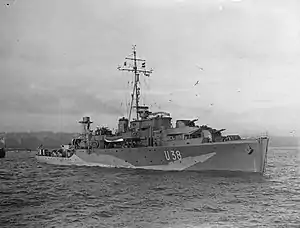HMS Cygnet (U38)
HMS Cygnet was a modified Black Swan-class sloop of the Royal Navy. She was laid down by Cammell Laird, Birkenhead on 30 August 1941, launched on 28 July 1942 and commissioned on 1 December 1943, with the pennant number U38.[1]
 HMS Cygnet anchored in 1943. | |
| History | |
|---|---|
| Name: | Cygnet |
| Namesake: | Cygnet |
| Ordered: | 27 March 1941 |
| Builder: | Cammell Laird, Birkenhead |
| Laid down: | 30 August 1941 |
| Launched: | 28 July 1942 |
| Commissioned: | 1 December 1943 |
| Decommissioned: | 1954 |
| Identification: | Pennant number: U38 |
| Status: | Scrapped in 1965 |
| General characteristics | |
| Class and type: | Modified Black Swan-class sloop |
| Displacement: | 1,350 tons |
| Length: | 283 ft (86 m) |
| Beam: | 38.5 ft (11.7 m) |
| Propulsion: |
|
| Speed: | 20 knots (37 km/h) at 4,300 hp (3,200 kW) |
| Complement: | 192 men + 1 Cat |
| Armament: |
|
Construction and career
After tests and its operational commissioning in November 1942 at Tobermory, HMS Cygnet was damaged by an air attack on December 9 which took it to a commercial shipyard on the Clyde in Scotland until March 1943.
In March 1943, he joined the 2nd Escort Group based in Liverpool and was deployed with the Group as part of an escort of a military convoy to Gibraltar on its return to the United Kingdom.
She was transferred in April 1943 to the 7th Escort Group based in Greenock to support convoys threatened with attack by U-Boote in the North Atlantic.
After a passage to the 2nd Escort Group in May 1943 for the protection of the ONS8 convoy, he returned to the 7th Escort Group in June 1943, Cygnet joined the defense group of military convoys during the passage through the Mediterranean for the planned Allied landings of Sicily as part of Operation Husky.
In early 1944, he joined the Home Fleet and participated in several protections of Arctic convoys as well as the defense of Atlantic convoys.
On April 8, 1944, the Cygnet with the sloop HMS Crane sank the U-962 in the North Atlantic north-west of Cape Finisterre by depth charges.
On April 13, 1944, it was damaged by its grounding on entering Belfast, depriving it of actions during the Normandy landings.
It resumed the protection of convoys from July 1944 until the end of the war in Europe leaving or arriving from Kola Bay. At the end of May, he was appointed to join the Pacific. She entered a commercial yard in Leith for repairs and improvements for her future theater of operations until early September, or during sea trials after the refit, she was again damaged by a grounding and had to resume repairs.
The order to leave for the Pacific was canceled following the dropping of atomic bombs on Hiroshima and Nagasaki and the subsequent surrender of Japan.[2]
References
- "HMS Cygnet (U 38) of the Royal Navy - British Sloop of the Modified Black Swan class - Allied Warships of WWII - uboat.net". uboat.net. Retrieved 21 October 2020.
- "HMS Cygnet, sloop". www.naval-history.net. Retrieved 21 October 2020.
Further readings
- Blackman, Raymond V. B. (1971). Jane's Fighting Ships 1971–72. London: Sampson Low, Marston & Company. ISBN 0-354-00096-9.
- Blair, Clay Gardiner (2000). Hitler's U-Boat War: The Hunted 1942–1945. Vol. 3. New York: Modern Library. ISBN 0-679-64033-9.
- Gardiner, Robert Gardiner (1980). Conway's All the World's Fighting Ships (1922-1946). Vol. 3. Conway Maritime Press. p. 456. ISBN 0-85177-146-7.
- Gardiner, Robert Gardiner (1996). Conway's All the World's Fighting Ships (1947-1995). Vol. 4. US Naval Institute Press. p. 675. ISBN 1-55750-132-7.
- Colledge, J. J.; Warlow, Ben (2006) [1969]. Ships of the Royal Navy: The Complete Record of all Fighting Ships of the Royal Navy (Rev. ed.). London: Chatham Publishing. ISBN 978-1-86176-281-8.
- Hague, Arnold (1993). Sloops: A History of the 71 Sloops Built in Britain and Australia for the British, Australian and Indian Navies 1926–1946. Kendal, England: World Ship Society. ISBN 0-905617-67-3.